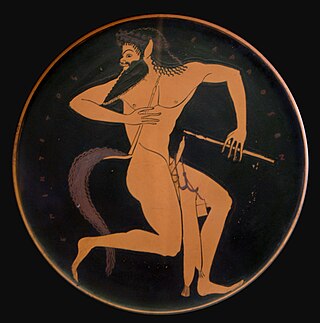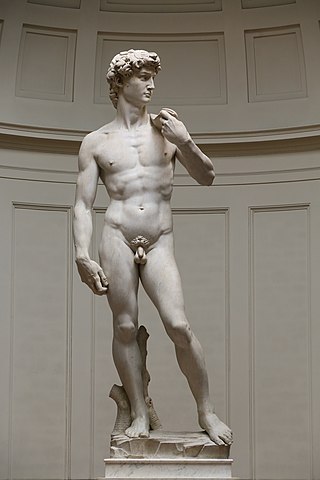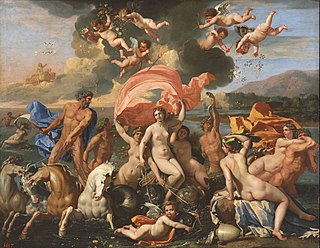
In Greek mythology, a satyr, also known as a silenus or silenos, and selini (plural), is a male nature spirit with ears and a tail resembling those of a horse, as well as a permanent, exaggerated erection. Early artistic representations sometimes include horse-like legs, but, by the sixth century BC, they were more often represented with human legs. Comically hideous, they have mane-like hair, bestial faces, and snub noses and they always are shown naked. Satyrs were characterized by their ribaldry and were known as lovers of wine, music, dancing, and women. They were companions of the god Dionysus and were believed to inhabit remote locales, such as woodlands, mountains, and pastures. They often attempted to seduce or rape nymphs and mortal women alike, usually with little success. They are sometimes shown masturbating or engaging in bestiality.

Giovanni Battista Tiepolo, also known as GiambattistaTiepolo, was an Italian painter and printmaker from the Republic of Venice who painted in the Rococo style, considered an important member of the 18th-century Venetian school. He was prolific, and worked not only in Italy, but also in Germany and Spain.

The Sistine Chapel ceiling, painted in fresco by Michelangelo between 1508 and 1512, is a cornerstone work of High Renaissance art.

Ca' Rezzonico is a palazzo and art museum on the Grand Canal in the Dorsoduro sestiere of Venice, Italy. It is a particularly notable example of the 18th century Venetian baroque and rococo architecture and interior decoration, and displays paintings by the leading Venetian painters of the period, including Francesco Guardi and Giambattista Tiepolo. It is a public museum dedicated to 18th-century Venice and one of the 11 venues managed by the Fondazione Musei Civici di Venezia.

A kinnara is a creature from Hindu and Buddhist mythology. They are described as part human and part bird, and have a strong association with music and love. Believed to come from the Himalayas, they often watch over the well-being of humans in times of trouble or danger. An ancient Indian string instrument is known as the Kinnari vina. Their character is also clarified in the Adi Parva of the Mahabharata, where they say:
We are everlasting lover and beloved. We never separate. We are eternally husband and wife; never do we become mother and father. No offspring is seen in our lap. We are lover and beloved ever-embracing. In between us we do not permit any third creature demanding affection. Our life is a life of perpetual pleasures.

A putto is a figure in a work of art depicted as a chubby male child, usually naked and very often winged. Originally limited to profane passions in symbolism, the putto came to represent a sort of baby angel in religious art, often called cherubs, though in traditional Christian theology a cherub is actually one of the most senior types of angel.

Bacchus (1496–1497) is a marble sculpture by the Italian High Renaissance sculptor, painter, architect and poet Michelangelo. The statue is somewhat over life-size and represents Bacchus, the Roman god of wine, in a reeling pose suggestive of drunkenness. Commissioned by Raffaele Riario, a high-ranking Cardinal and collector of antique sculpture, it was rejected by him and was bought instead by Jacopo Galli, Riario's banker and a friend to Michelangelo. Together with the Pietà, the Bacchus is one of only two surviving sculptures from the artist's first period in Rome.

The nude, as a form of visual art that focuses on the unclothed human figure, is an enduring tradition in Western art. It was a preoccupation of Ancient Greek art, and after a semi-dormant period in the Middle Ages returned to a central position with the Renaissance. Unclothed figures often also play a part in other types of art, such as history painting, including allegorical and religious art, portraiture, or the decorative arts. From prehistory to the earliest civilizations, nude female figures were generally understood to be symbols of fertility or well-being.

The Goat Amalthea with the Infant Jupiter and a Faun is the earliest known work by the Italian artist Gian Lorenzo Bernini. Produced sometime between 1609 and 1615, the sculpture is now in the Borghese Collection at the Galleria Borghese in Rome.

The Cardinal and Theological Virtues is a lunette fresco by Raphael found on the south wall of the Stanza della Segnatura in the Apostolic Palace of the Vatican. Three of the cardinal virtues are personified as statuesque women seated in a bucolic landscape, and the theological virtues are depicted by putti.

Female Herm and Male Herm are a set of two neoclassical marble herms in the outdoor sculpture collection of the historic Oldfields estate, located on the campus of the Indianapolis Museum of Art (IMA), in Indianapolis, Indiana. Together the herms depict either Dionysus and a Maenad or a dryad and a satyr.
The Four Seasons are a set of four stone allegorical putti, each representing a traditional, temperate season. These are a part of the outdoor sculpture collection of the historic Oldfields estate, located on the campus of the Indianapolis Museum of Art (IMA), in Indianapolis, Indiana.

Damned Soul is a marble sculpture bust by the Italian artist Gian Lorenzo Bernini as a pendant piece to his Blessed Soul. According to Rudolf Wittkower, the sculpture is in the Palazzo di Spagna in Rome. This may well be what is known today as the Palazzo Monaldeschi.

Bacchanal: A Faun Teased by Children is a marble sculpture by Italian artists Gian Lorenzo Bernini and his father Pietro Bernini. It was executed in 1616 and 1617, when Gian Lorenzo was not yet twenty years old. It is currently in the Metropolitan Museum of Art in New York.

Leda and the Swan is an oil painting by Peter Paul Rubens, who painted two versions of this subject. The first was completed in 1601 and the second in 1602.

The Five Senses is a set of allegorical paintings created at Antwerp in 1617-1618 by Jan Brueghel the Elder and Peter Paul Rubens, with Brueghel being responsible for the settings and Rubens for the figures. They are now in the Prado Museum in Madrid. They are all painted in oils on wood panel, approximately 65 by 110 centimetres in dimensions.

Giovanni Andrea Podestà or Giovanni Andrea Podesta was an Italian painter and engraver who was principally active in Rome. His principal subject matter is children playing in landscapes with classical objects. His works show the influence of Poussin's Arcadian landscapes and bacchanals, which were ultimately derived from Titian's bacchanals.

A puer mingēns is a figure in a work of art depicted as a prepubescent boy in the act of urinating, either actual or simulated. The puer mingens could represent anything from whimsy and boyish innocence to erotic symbols of virility and masculine bravado.

The Tomb of Ferdinand van den Eynde is a sculptural monument designed and executed by François Duquesnoy. It is located in the church of Santa Maria dell'Anima in Rome. Duquesnoy secured the commission for this work thanks to Pietro Pescatore, alias De Visschere, or Pieter Visscher, a Flemish merchant. The site for Eynde's epitaph was granted by the church administration on August 3, 1633. Visscher and Baldoin Breyel were charged with overseeing the tomb's execution. Both of them had been friends of the deceased, who belonged to the expatriate Netherlandish community of Santa Maria dell'Anima in Rome. The tomb was completed between 1633 and 1640.

The Triumph of Neptune and Amphitrite by Nicolas Poussin, painted in 1635 or 1636, is a painting housed in Philadelphia in the Philadelphia Museum of Art. It is in oil on canvas and shows a group of figures in the sea near a beach, with putti flying over their heads.




















